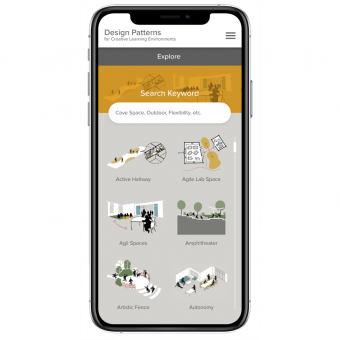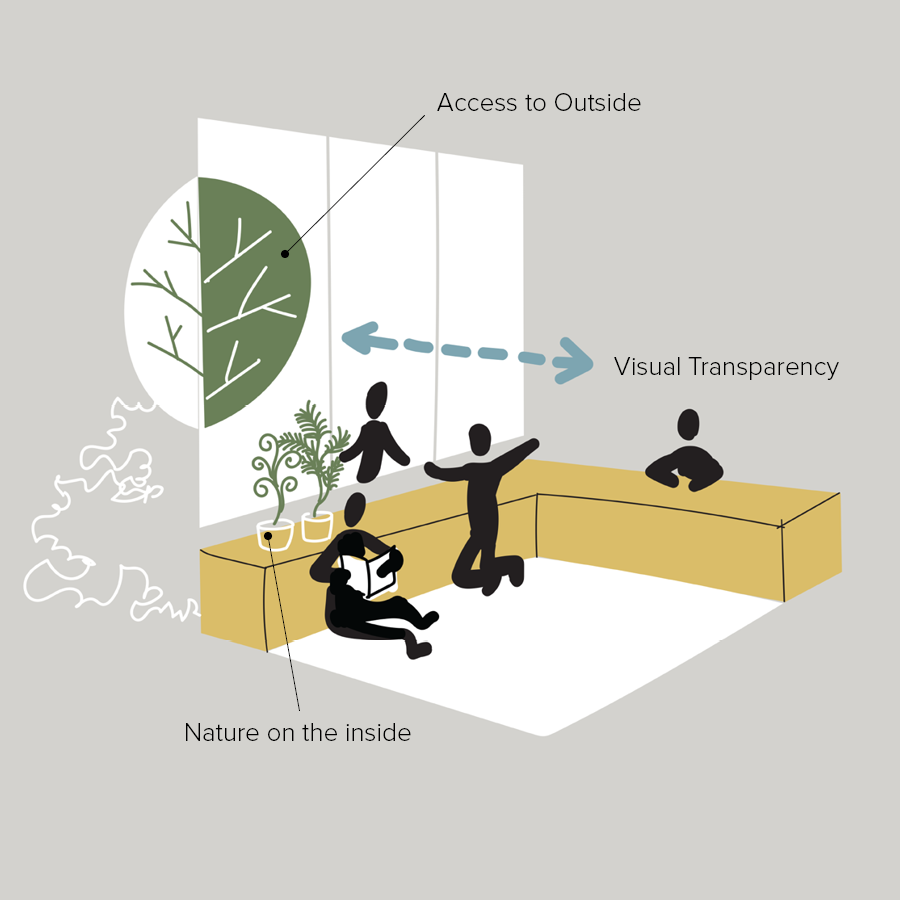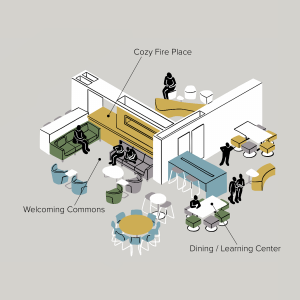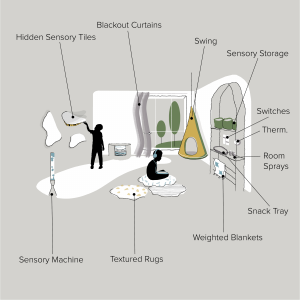
Understanding how the learning environment can work to support or suppress the full range of social, emotional and educational needs of students is paramount.
Many schools still feature a “cells and bells” model of rigidly defined classrooms and corridors which lack the key elements of human-centered design. However, the vision for student wellness has shifted to spaces and activities that focus on empowering individuals, strengthening relationships, and getting to deeper learning through authentic problem solving. New physical environments are needed for integrating these goals for learning while adapting to the unique spectrum of social and emotional needs that each learner brings.
In Fielding International’s work, students surveyed have voiced that they want spaces where they feel like they can go to have a moment to decompress, to do work alone, to connect with a mentor/counselor, or to get fresh air. Many feel they need places outside of open corridors or someone’s particular office. They really just want spaces that they can go and be themselves.
What we also hear is that students want to break down the stigma of going and seeking the help that they need. They want to make accessing help and guidance more inviting, more comfortable, and more commonplace.
To address and explore physical spaces within schools that support the social-emotional needs of students we can look to Design Patterns.
Design Patterns are ideas that provide the visual representation of how a space works. These key ideas break down the complexity of school design as part of a system. Through the use of Patterns we can identify problems, opportunities, and solutions to design and connect successful educational environments and experiences. Design Patterns take an idea and make it visual so that we can more easily “see” what is important.
While it is not uncommon for a school to use 20+ Design Patterns to create a system of cohesive spaces, below are four Patterns we feel can help schools develop a more social-emotional friendly environment:
Calming Retreat

Spaces appropriate for SEL and self-regulation need to be made accessible. Whether for meditative reflection, guided self-regulation, or simple “brain breaks,” these spaces serve as a resource for the school to build resilience and mindful practices.
A Pattern such as “Calming Retreat” distributes dedicated spaces for individual reflection, mindfulness practices, and emotional regulation. Specific aspects of these types of spaces include views to outside, comfortable seating for up to three people, space for personal movement, proximity to communal spaces for ease of access, and partitions for privacy and group activities.
Indoor/Outdoor Connections

Our relationship with nature is also a critical factor in supporting mental health. Being in natural environments, or even viewing nature, reduces anger, fear, and stress, contributing to physical wellbeing. Yet, students often spend the majority, or all, of the school day indoors. Furthermore, many buildings only provide windows on one side of a classroom with students forced to face away from the outdoors.
As a way to ensure students have access to nature, it is essential that schools have strong “Indoor-Outdoor Connections.” This Pattern forms a natural link to extend indoor learning spaces beyond the walls of the school. This can be achieved by incorporating the following features: numerous exterior vistas; outdoor project porches, learning terraces, and upper-level learning balconies; outdoor seating areas for reading, eating, conversing, etc.; and natural and landscaped features such as trails, bodies of water, gardens, and playfields.
The Family Room

With “The Family Room” Design Pattern, social-emotional learning can be effectively developed in partnership with parents and the community. In fact, research has shown there to be many benefits when parents are involved in their children’s education, yet schools consistently struggle with parent engagement.
Parent involvement typically declines as students grow older, and there is a significant drop in involvement between elementary and secondary school. This can be for many reasons, such as parents lacking the time, resources, or know-how to help out, or they do not feel welcomed at school, which can be addressed through the physical environment.
There are many ways to leverage “The Family Room.” You can dedicate a space for parents, grandparents, local elders, community partners to be at the school. Oftentimes more relaxed, informal spaces are conducive to social interactions between students, teachers, parents, and community members. Connections to outdoor spaces and food can be another element of this supportive space.
Sensory Control

Within traditional learning spaces, some learners, especially those with sensory processing disorders (including autism), experience negative reactions to spaces with conflicting or overwhelming sensory stimuli, often causing them to become distracted or upset. Examples include bright or contrasting lighting, the hum of mechanical systems, or overwhelming patterns or textures. How might we design an environment to help learners positively regulate sensory information and/or de-escalate sensory overload?
The “Sensory Control” Design Pattern creates space intentionally designed to provide a controlled and predictable stimulus that includes but is not limited to access to tactile displays, dimmable lights, colors, textures, and bold patterns. The space encourages tactile interaction and non-restrictive movement, especially soothing motions, like back-and-forth, side-to-side, or up-and-down. Most importantly, the use of this Design Pattern gives the learner a predictable place where they have the freedom to choose to engage (or not engage) with the stimuli, empowering their experience in the environment.
Other Patterns such as Cave Space, Student Lounge, Daylighting, Presence of Water, and many more can be found at SchoolPatterns.com.
The 70+ of Fielding International’s Design Patterns shared on SchoolPatterns.com have been used in the planning and design of schools around the world. Design Patterns, such as the ones highlighted here that support social-emotional learning, can help from the beginning stages of a school design through visioning and ideation, to the preparation of educators on how to use the built space effectively and maximize the learning experience. Having Design Patterns as a resource at each stage in the process improves the quality of understanding and communication, which in turn aligns the goal to design a school where learners thrive.
